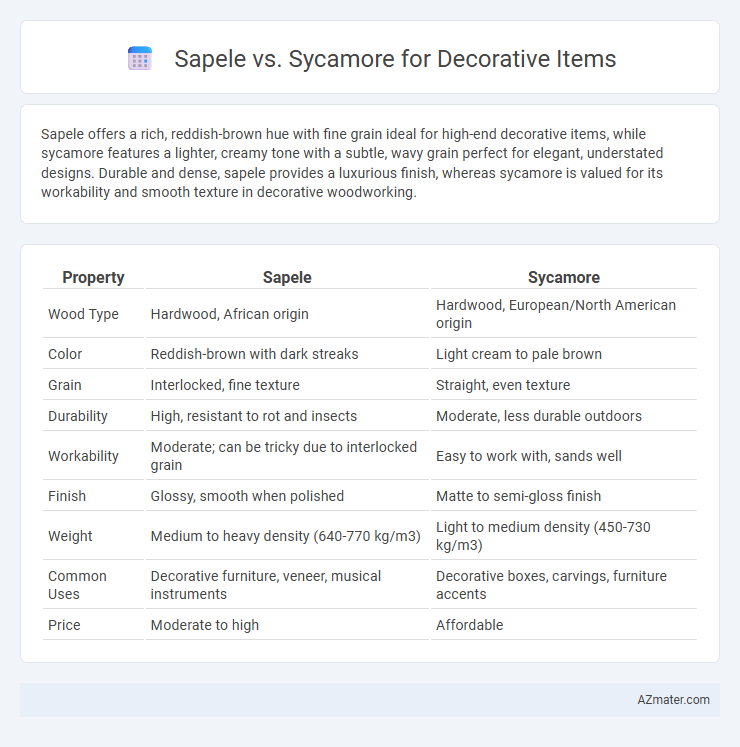Sapele offers a rich, reddish-brown hue with fine grain ideal for high-end decorative items, while sycamore features a lighter, creamy tone with a subtle, wavy grain perfect for elegant, understated designs. Durable and dense, sapele provides a luxurious finish, whereas sycamore is valued for its workability and smooth texture in decorative woodworking.
Table of Comparison
| Property | Sapele | Sycamore |
|---|---|---|
| Wood Type | Hardwood, African origin | Hardwood, European/North American origin |
| Color | Reddish-brown with dark streaks | Light cream to pale brown |
| Grain | Interlocked, fine texture | Straight, even texture |
| Durability | High, resistant to rot and insects | Moderate, less durable outdoors |
| Workability | Moderate; can be tricky due to interlocked grain | Easy to work with, sands well |
| Finish | Glossy, smooth when polished | Matte to semi-gloss finish |
| Weight | Medium to heavy density (640-770 kg/m3) | Light to medium density (450-730 kg/m3) |
| Common Uses | Decorative furniture, veneer, musical instruments | Decorative boxes, carvings, furniture accents |
| Price | Moderate to high | Affordable |
Introduction: Sapele vs Sycamore for Decorative Items
Sapele wood, known for its rich reddish-brown hue and fine interlocking grain, offers durability and a luxurious appearance ideal for high-end decorative items. Sycamore features a pale, creamy color with a consistent, smooth texture that highlights intricate carvings and detailed work. Choosing between Sapele and Sycamore depends on the desired aesthetic and the functional requirements of the decorative piece.
Origin and Botanical Background
Sapele, botanically known as Entandrophragma cylindricum, is a hardwood native to tropical Africa, primarily found in countries such as Nigeria, Cameroon, and the Democratic Republic of Congo, renowned for its rich reddish-brown hue and fine interlocked grain. Sycamore, derived from the Platanus genus, is a deciduous hardwood native to North America, Europe, and parts of Asia, characterized by its pale, creamy color and distinctive mottled grain pattern. The contrasting botanical origins of Sapele and Sycamore influence their coloration, grain texture, and workability, making them uniquely suited for different styles of decorative items.
Appearance and Grain Patterns
Sapele exhibits a rich reddish-brown hue with a fine, interlocking grain that creates a striking ribbon-like pattern, making it highly desirable for decorative items requiring a luxurious and warm aesthetic. Sycamore features a lighter, creamy to pale brown color with a subtle, straight grain pattern and occasional wavy or curly figure, offering a more understated and delicate appearance. The choice between Sapele and Sycamore for decorative items depends on whether a bold, elegant look or a soft, refined finish is preferred.
Color Variations and Aging
Sapele wood features a rich reddish-brown hue that deepens with age, developing a warm, lustrous patina ideal for decorative items seeking an elegant, classic look. Sycamore offers a lighter, creamy to pale brown color with subtle grain patterns that mellow softly over time, providing a more understated, natural aesthetic. Both woods age beautifully, but Sapele's pronounced color variation enhances visual depth, while Sycamore's subtle aging emphasizes simplicity and versatility.
Durability and Hardness Comparison
Sapele wood exhibits a Janka hardness of approximately 1,410 lbf, making it notably more durable and resistant to dents and scratches than Sycamore, which has a Janka hardness around 950 lbf. The high density and interlocking grain structure of Sapele contribute to its superior durability, ideal for decorative items subjected to frequent handling. In contrast, Sycamore's softer texture makes it more susceptible to surface wear, limiting its use for intricate or high-impact decorative applications.
Workability and Crafting Ease
Sapele wood offers excellent workability with a fine grain that allows for smooth sanding and intricate detailing, making it ideal for decorative items requiring precision. Sycamore features a slightly coarser grain but carves well and finishes smoothly, providing good crafting ease for medium-detailed designs. Both woods are stable and resist warping, but Sapele's higher density demands sharper tools and more skill, whereas Sycamore is more forgiving for beginners.
Finishing Characteristics
Sapele wood offers a rich, reddish-brown hue with a fine, even grain that polishes to a smooth, lustrous finish, making it ideal for decorative items requiring a sophisticated appearance. Sycamore features a paler, creamy tone with a subtle wave grain, providing a soft, matte finish that emphasizes its natural texture and subtle figure. Both woods respond well to sanding and sealing, but Sapele's denser fibers yield a more durable and glossy surface compared to the lighter, more porous nature of Sycamore.
Cost and Availability
Sapele offers a luxurious reddish-brown hue with a smooth grain, often priced higher due to its durability and aesthetic appeal, making it a preferred choice for premium decorative items. Sycamore presents a lighter, more neutral tone with a consistent grain pattern and is generally more affordable and readily available in many regions. Cost-effectiveness combined with easier sourcing often makes sycamore ideal for large-scale decorative projects while sapele suits high-end, intricate designs.
Best Decorative Uses for Sapele and Sycamore
Sapele wood excels in decorative items such as intricate carvings, fine furniture, and musical instruments due to its rich reddish-brown hue and striking grain patterns. Sycamore's pale, creamy color and smooth texture make it ideal for delicate inlays, turned objects, and sculptural pieces that benefit from subtle elegance. Both woods offer unique aesthetic qualities, with Sapele providing warmth and depth while Sycamore delivers brightness and a refined finish.
Choosing the Right Wood: Sapele or Sycamore
Sapele offers rich, reddish-brown tones with a fine, consistent grain, making it ideal for decorative items that require elegance and durability. Sycamore wood features a lighter, creamy color with a delicate, wavy grain pattern, lending a softer, more subtle aesthetic to ornamental pieces. Selecting between Sapele and Sycamore depends on the desired visual impact and the item's exposure to wear, with Sapele favored for its hardness and rich color, while Sycamore suits designs needing lighter hues and smoother textures.

Infographic: Sapele vs Sycamore for Decorative Item
 azmater.com
azmater.com